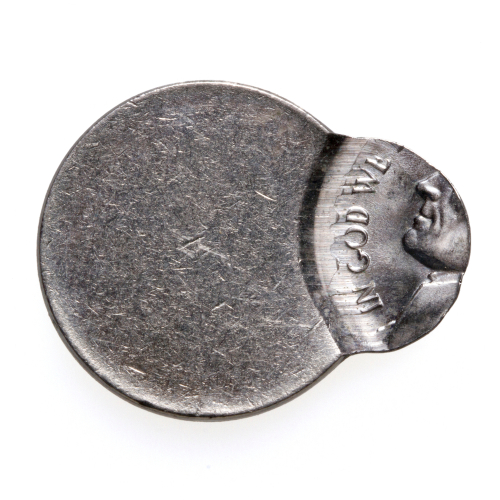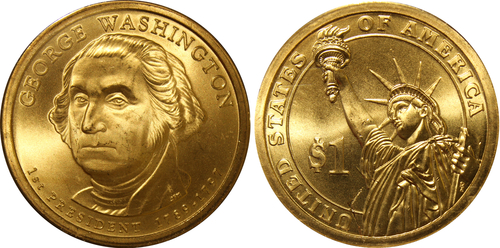
Take a handful of quarters, dimes, nickels and pennies out of your change jar and, if you inspect each coin closely, you might find one with a small error. Maybe the coin has an off-center strike, was struck twice or is missing a key design element. When a mint makes a mistake such as this, we refer to it as a mint-made error. The goal of the mint is of course to make perfectly uniform change, but as coin collectors, we can’t help but get excited when something’s not quite perfect. Occasionally, error coins become collectible coins, and they are always fascinating to numismatic-lovers.
Generally speaking, error coins occur due to a malfunction in the minting equipment or because something gets offset. Some of the more common coin errors include issues with striking, such as off-center strikes or multiple strikes, and brockages, which happen when a coin gets stuck in the press. The major mints do also have error-prevention equipment, including riddling devices, which help to prevent misprinted coins from leaving the mint. Still, mistakes happen and, on occasion, the results make it out the mint doors.
What Happens to Error Coins?
There’s no way of knowing how common mint-made errors are, as the mint does not report the data, but we do know that it’s relatively easy to find errors in modern currency. How do we know? Because error coins are sometimes put into circulation for us to find. Here are some of the things that might happen to a mistake coin once it’s identified as such.
- They’re Destroyed—The United States Mint usually catches errors made during the manufacturing process and will destroy error coins if they are able to identify them before the coins leave the mint. If the error is slight, the mint may allow the coin to enter circulation.
- They’re Put into Circulation—There are many reasons why an error coin might become a part of the general money pool—perhaps it entered circulation by accident, by the hands of an unscrupulous employee or because the mistake was not big enough to warrant a do-over.
- They’re Sold—Once error coins make it into circulation, they may become sought-after among collectors. Big, noteworthy errors (see examples below) will fetch collectors a pretty penny, so to speak, so they are often sold and traded among coin collectors.
- They’re Collected—Those in the general public who are aware that mistake coins can be valuable will often sift through their change to identify errors. Many collectors opt to save these error coins and add them to their collections.

When Error Coins Become Collectible Coins
Mint-made errors are often considered happy accidents to coin collectors. Though coins come out imperfect relatively often, there are some mint-made mistakes that can cause average coinage to become rare, sought-after and therefore valuable. The following are some of the more valuable imperfect coins, but there are many more good examples:
- The 2004 Wisconsin Quarter—The 2004 Wisconsin issue of the 50 State Quarters came with a fascinating error. Some of the coins were imprinted with an extra leaf on the corn husk, which is actually just an accidental die gauge.
- The 1946-S Copper Cent—If you can find one, a 1946-S wheat penny makes an awesome addition to your book of rare coins. For a period in 1946, it was mistakenly overpunched with an S over D mint mark.
- The 2007 Presidential Dollar—Some 2007 George Washington $1 coins were accidentally released into circulation without edge inscriptions, including the words “In God We Trust” and “E Pluribus Unum,” earning them the nickname “Godless dollars.”
- The 1918/7 Buffalo Nickel—This early example of a minting error is extremely rare. It features an overpunched 8 over 7 which occurred as a result of a hubbing error that caused the die to be impressed with two different dates.

Collecting Error Coins
If you can get your hands on some of these “happy accident” coins, you might be in luck! Consider this: In 2010, an error coin—the 1943 D Bronze Cent, famed for the fact that it was mistakenly struck on bronze planchets—sold for $1.7 million. Talk about an investment!
Provident Metals is your one-stop shop for all things numismatics, whether you’re looking for investment-grade bullion coins or one-of-a-kind rarities that will complete your collection.




how abnormal can a penny get, this penny must be one of a kind. a quad tripple dd.
i sure would like the world of people who love coins to see the holygrail.
some contact me please
I have a penny that has a insect embedded in it. Is it worth anything.
Error coins are awesome to find when it’s least expected… usually innpocket change.
Nice to learn few tid bits, Might help me not let something next time, slip right by me, right underneath my nose, As I know that did happen one time, concerning coins, I had found as teenager, 1909 VDF Wheat penny, In natural like, sandy spot, approx 20′ x 8 area, in FL, next to an old barn like structure & had S mint mark, I know, bc I look at coin closely when I found it and remember those initials still, even after losing this coin, where, I don’t know. while I was still young, then come find out, decades later on internet, I found out what those initials were and the story behind it.Don’t think hardly anyone had computers in their home during that time period, back then, either. P.S. I finally did, perhaps, forget, Order of these letters VDF?